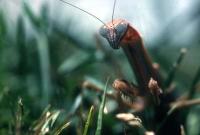
Hungry female praying mantids are more likely to cannibalize.Female praying mantids are notorious for sexual cannibalism – that is, for eating their male partner during mating. However, the possibility that males may also have something to gain from this violent act has never been resolved experimentally. In a paper in the August issue of The American Naturalist, Jonathan Lelito and William Brown (SUNY-Fredonia), study male risk-taking behavior in a praying mantis by altering the risk of cannibalism and observing changes in male behavior. They find that the males are able to assess the risk of cannibalism and become more cautious in the presence of particularly hungry females.
"We know that hungry females are more likely to cannibalize and a head-on orientation makes it easier for her to attack the male with her predatory front legs," says Brown.
Lelito and Brown thus varied female hunger and physical orientation in order to assess how male mantids respond to variation in the risk of cannibalism. They found that males responded to greater risk by slowing their approach, increasing courtship behavior, and mounting from a greater – and possibly safer – distance.
"This shows that male mantids actively assess variation in risk and change their behavior to reduce the chance of being cannibalized," explains Brown. "Males are clearly not complicit, and the act of sexual cannibalism in praying mantids is an example of extreme conflict between the sexes."
Source : University of Chicago Press Journals
 Print Article
Print Article Mail to a Friend
Mail to a Friend
